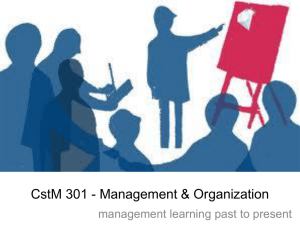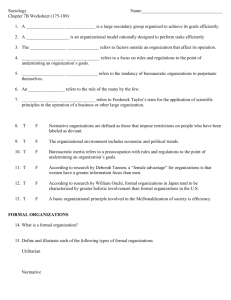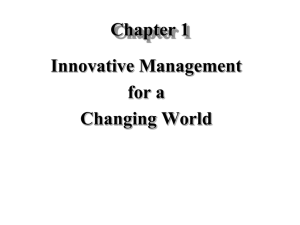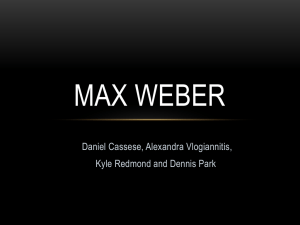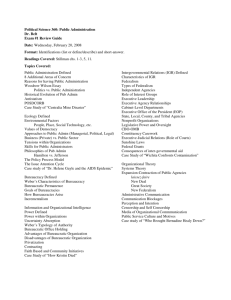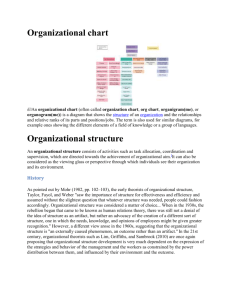ORGANIZATIONAL THEORY
advertisement
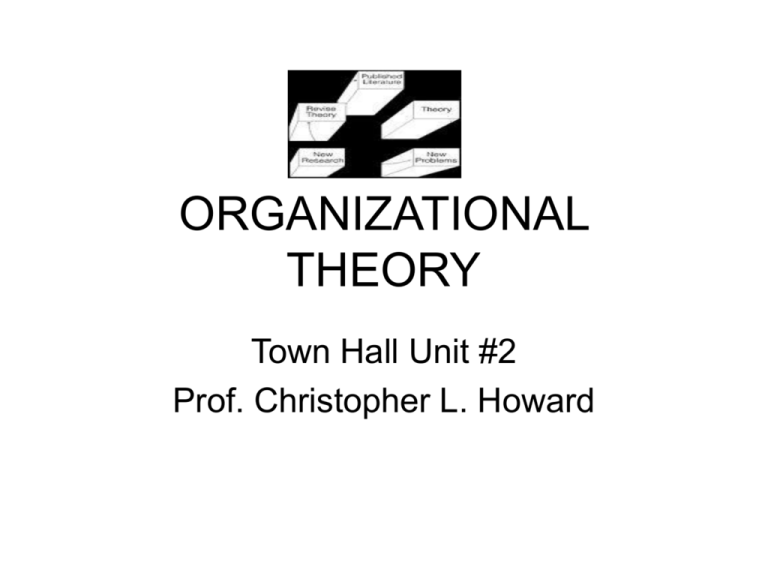
ORGANIZATIONAL THEORY Town Hall Unit #2 Prof. Christopher L. Howard Organizational Theory defined….sort of??? • Organizational behavior is currently a growing field. Organizational studies departments generally form part of business schools, although many universities also have industrial psychology and industrial economics programs. • The field is highly influential in the business world with practitioners like Peter Drucker and Peter Senge, who turned the academic research into business practices. Organizational behaviour is becoming more important in the global economy as people with diverse backgrounds and cultural values have to work together effectively and efficiently. It is also under increasing criticism as a field for its ethnocentric and pro-capitalist assumptions (see Critical Management Studies). • During the last 20 years organizational behavior study and practice has developed and expanded through creating integrations with other domains: • http://en.wikipedia.org/wiki/Organizational_studies Bureaucratic Model • • • • • For Weber - the organisation is "neutral" (a big, big assumption and one to be challenged). It is presented as a technically useful model of the most logically efficient form of structure possible. "Precision, speed, unambiguity, knowledge of files, continuity, unit, strict subordination, reduction of friction and of material and personal costs - these are raised to the optimum point in the strictly bureaucratic administration". Though metaphorically a smooth machine its rules and set procedures can be inflexible instruments of administration - experience of the past may not be intune with present conditions. Some rules cannot be readily adapted to suit individual needs and thgey can become barriers behind which the vulnerable administrator to hide. Bureaucratic alienation is reinforced by conformations with "face-less administrators" A tension occurs in organisational design between preserving control and encouraging flexibility & freedom of expression. Bureaucracy favours the former. Cries of "bureaucratic inefficiency" marks frustration of taxpayers, drivers, holiday makers, radical activists, people from other departments who feel their personal domain has been infringed. Bureaucracy today is attacked for its inability to innovate, aspects of its alienating and demotivating effect on employees, and the dependen "unhealthy" relationships some feel it creates (rather than self- help). Bureaucratic culture rewards safe, conformist attitudes - constrained, riskfree work is good. Nonconformist, creative and outward-looking, opportunistic approaches to management are suspect. The bureaucratic model by definition embodies depersonalisation. Bureacrats become more absorbed with maintaining the official form (the means). They lose sight of what they are supposed to achieve. Smooth, efficient running removes hassle for officers but may be effective (as valued by clients)? http://www.bola.biz/systems/bureau.html Bureaucratic Model Continued • • • • • • • • • Delegation and the Bureaucratic Form Bureaucratic structures emphasise specialisation between jobs and departments, reliance on formal procedures and paperwork, extended managerial reporting structures and clearly marked status definitions. Job demarcation is an informal, interpersonal response by individuals and groups which may be at odds with the firm's objectives. Demarcation may be supported by trades union preferences. It is manifested also in officer rivalries and empire-building. If the firm becomes large & complex it bears formal & informal overheads of possible inefficiency. Bureaucracies employ a system of delegation down these hierarchies. Employees use discretion only within delegated limits. Job roles are defined formally (often in writing) by profiles of task responsibility and /her authority - scope of discretion to act. An organistional principle is that job responsibilities require equivalent authority to carry these out. But authority comprises:formal (job) authority - others know your responsibilities and their reporting relationships personal (interpersonal) authority - secure others co- operation resource authority (hours, staff, budget, rewards) for the task expertise authority: having the skills, knowledge and experienceto carry out the responsibilities. The authority of language and hetoric which may be difficult to argue against as all seems so plausible. Though posts are hierarchical with successive steps embracing all those beneath it - problems of role ambiguity, conflict & overload frequently occur. Delegation is a complex process reliant on managers' ability to communicate well with subordinates and obtain common perception of jobÊrequirements (so too with colleagues with whom the post interfaces). http://www.bola.biz/systems/bureau.html Bureaucratic Model contingencies • • • • • • • Coping with Contingencies. Within Weber's model, rules and procedures aim to anticipate every possible contingency. Top management "know" that lower level staff are acting in controlled ways. This control is underpinned by training, briefing and observation/guidance by the superior. Loyalty and cooperation is expected. Officers should carry out their duties to the letter - without overstepping their role and conflicting with others duties. This assumes a perfect communication and cooperation - formally and interpersonally. Of course where the person in terms of aptitude, skill and motivation is cheesed off or feels rivalry towards others or feels like being bloody-minded - problems arise. Fitting the job to the person and the person to the job is a key task for the personnel management of bureaucracy. For officers, there clear separation between personal and business affairs. "When I am at work, I do my job without personal feelings/biases entering into it!" This is bolstered by contract & technical qualifications (techno-meritocracy). Instructions are obeyed because appointment assumes competence to issue such commands. A sign of developing bureaucracy is the growth of professional managers and more specialist/departmental experts. Manager-experts maintain the fabric of the existing firm and develop new responses (policies and practices) to external and internal events/conditions. Information, Records and Decision-support. The "bureau" keeps records and files. System rationality demands that information is written down. The organisation can reference and compare past decisions to ensure consistency. Records and structure make the organisation concrete. It will continue even though the people who run it change. Policies, procedures, minutes, reports, records show it operating dynamically. The bureaucratic model implies a programmed organisation. Procedures and rules are algorithmic ie routinised solutions to known, common problems ie like computer programs. Records, policies and procedures provide a knowledge-base minimising risk and maximising consistency in decision-making.. http://www.bola.biz/systems/bureau.html Scientific Management • Scientific management was a theory of management that analyzed and synthesized workflows. Its main objective was improving economic efficiency, especially labor productivity. The core ideas of the theory were developed by Frederick Winslow Taylor in the 1880s and 1890s, and were first published in his monographs Shop Management (1903)[1] and The Principles of Scientific Management (1911).[2] While working as a lathe operator and foreman, Taylor noticed the natural differences in productivity between workers, which were driven by various causes, including differences in talent, intelligence, or motivations. He was one of the first people to try to apply science to this application, that is, understanding why and how these differences existed and how best practices could be analyzed and synthesized, then propagated to the other workers via standardization of process steps. He believed that decisions based upon tradition and rules of thumb should be replaced by precise procedures developed after careful study of an individual at work, including via time and motion studies. Scientific management's application was contingent on a high level of managerial control over employee work practices. This necessitated a higher ratio of managerial workers to laborers than previous management methods. It also caused interpersonal friction between workers and managers, and social tensions between the blue-collar and white-collar classes. • http://en.wikipedia.org/wiki/Scientific_management Hawthorne Effect • • • • • • • The major finding of the study was that almost regardless of the experimental manipulation employed, the production of the workers seemed to improve. One reasonable conclusion is that the workers were pleased to receive attention from the researchers who expressed an interest in them. The study was only expected to last one year, but because the researchers were set back each time they tried to relate the manipulated physical conditions to the worker's efficiency, the project extended out to five years. Four general conclusions were drawn from the Hawthorne studies: The aptitudes of individuals are imperfect predictors of job performance. Although they give some indication of the physical and mental potential of the individual, the amount produced is strongly influenced by social factors. Informal organization affects productivity. The Hawthorne researchers discovered a group life among the workers. The studies also showed that the relations that supervisors develop with workers tend to influence the manner in which the workers carry out directives. Work-group norms affect productivity. The Hawthorne researchers were not the first to recognize that work groups tend to arrive at norms of what is "a fair day's work," however, they provided the best systematic description and interpretation of this phenomenon. The workplace is a social system. The Hawthorne researchers came to view the workplace as a social system made up of interdependent parts. http://www.nwlink.com/~donclark/hrd/history/hawthorne.html Organizational Humanism • ORGANIZATIONAL HUMANISM is a set of organization theories which stress that work holds intrinsic interest and value for the worker. Workers seek satisfaction in their work, want to work rather than avoid it, and can be motivated through systems of positive incentives, such as participation in decision making [1]. Organizational humanists contend that the design of most organizations leads to highly specialized and routine jobs in which employees cannot use all their creative, motivated potential. They believe that employees are primarily self-motivated and self-controlled and react negatively to externally imposed controls. Organizational humanists suggest that the best role for a manager is to challenge employees, develop employee decision-making skills, and grant employees workplace responsibility. If jobs allow employees freedom to achieve self-actualization, they will be motivated and satisfied; conversely, if jobs limit employees’ sense of personal achievement and growth, they will not be satisfied with other incentives. If allowed to become self-actualized, employees will integrate their goals with those of the organization. In seeking to encourage innovation, many companies have challenged employees, sought to involve them fully in decision-making activities, and encouraged them to seek responsibility. • http://papedia.wikispaces.com/organizational+humanism Theories X and Y • THEORY X and THEORY Z Theory X posits that the average person dislikes work and will avoid it he/she can. Most people must be forced with the threat of punishment to work towards organizational objectives. The average person prefers to be directed and to avoid responsibility; the average person is relatively unambitious and wants security above all else[2]. In contrast, Theory Y posits that people will apply self-control and self-direction in the pursuit of organizational objectives, without external control or the threat of punishment. People usually accept and often seek responsibility. The capacity to use a high degree of imagination, ingenuity, and creativity in solving organizational problems is widely distributed in the population[3]. SELF-ACUALIZING VIEW Self-actualization refers to reaching one’s ultimate potential through the use of personal skills and talents. The organizational humanists believe that allowing employees greater freedom and satisfaction at work is more consistent with human nature than were earlier views. Because self-actualized employees are highly motivated, such changes should produce organizational benefits that cannot be achieved in hierarchical or traditional industrial organization [4]. • http://papedia.wikispaces.com/organizational+humanism Maslow’s Theory of Needs • Physiological Needs – • Safety Needs – • When the first three classes of needs are satisfied, the needs for esteem can become dominant. These involve needs for both selfesteem and for the esteem a person gets from others. Humans have a need for a stable, firmly based, high level of self-respect, and respect from others. When these needs are satisfied, the person feels self-confident and valuable as a person in the world. When these needs are frustrated, the person feels inferior, weak, helpless and worthless. Needs for Self-Actualization – • When the needs for safety and for physiological well-being are satisfied, the next class of needs for love, affection and belongingness can emerge. Maslow states that people seek to overcome feelings of loneliness and alienation. This involves both giving and receiving love, affection and the sense of belonging. Needs for Esteem – • When all physiological needs are satisfied and are no longer controlling thoughts and behaviors, the needs for security can become active. Adults have little awareness of their security needs except in times of emergency or periods of disorganization in the social structure (such as widespread rioting). Children often display the signs of insecurity and the need to be safe. Needs of Love, Affection and Belongingness – • These are biological needs. They consist of needs for oxygen, food, water, and a relatively constant body temperature. They are the strongest needs because if a person were deprived of all needs, the physiological ones would come first in the person's search for satisfaction. When all of the foregoing needs are satisfied, then and only then are the needs for self-actualization activated. Maslow describes self-actualization as a person's need to be and do that which the person was "born to do." "A musician must make music, an artist must paint, and a poet must write." These needs make themselves felt in signs of restlessness. The person feels on edge, tense, lacking something, in short, restless. If a person is hungry, unsafe, not loved or accepted, or lacking self-esteem, it is very easy to know what the person is restless about. It is not always clear what a person wants when there is a need for self-actualization. http://honolulu.hawaii.edu/intranet/committees/FacDevCom/guidebk/teachtip/maslow.htm Open Systems • An open system is a system which continuously interacts with its environment. The interaction can take the form of information, energy, or material transfers into or out of the system boundary, depending on the discipline which defines the concept (see below). An open system should be contrasted with the concept of an isolated system which exchanges neither energy, matter, or information with its environment. • The concept of an "open system" was formalized within a framework that enabled one to interrelate the theory of the organism, thermodynamics, and evolutionary theory.[1] This concept was expanded upon with the advent of information theory and subsequently systems theory. Today the concept has its applications in the natural and social sciences • http://en.wikipedia.org/wiki/Open_system_(systems_theory) Closed System • Isolated system that has no interaction with its external environment-a system without any input. Closed systems with outputs are knowable only thorough their outputs which are not dependent on the system being a closed or open system. Closed systems without any output are knowable only from within. See also entropy. • Read more: http://www.businessdictionary.com/definition/closedsystem.html#ixzz10NUjpX6x Theory Z • Theory Z is an approach to management based upon a combination of American and Japanese management philosophies and characterized by, among other things, long-term job security, consensual decision making, slow evaluation and promotion procedures, and individual responsibility within a group context. Proponents of Theory Z suggest that it leads to improvements in organizational performance. The following sections highlight the development of Theory Z, Theory Z as an approach to management including each of the characteristics noted above, and an evaluation of Theory Z. Realizing the historical context in which Theory Z emerged is helpful in understanding its underlying principles. • http://www.enotes.com/management-encyclopedia/theory-z Game Theory • • • Game theory is a branch of applied mathematics that is used in the social sciences, most notably in economics, as well as in biology (particularly evolutionary biology and ecology), engineering, political science, international relations, computer science, and philosophy. Game theory attempts to mathematically capture behavior in strategic situations, or games, in which an individual's success in making choices depends on the choices of others. While initially developed to analyze competitions in which one individual does better at another's expense (zero sum games), it has been expanded to treat a wide class of interactions, which are classified according to several criteria. Today, "game theory is a sort of umbrella or 'unified field' theory for the rational side of social science, where 'social' is interpreted broadly, to include human as well as non-human players (computers, animals, plants)" (Aumann 1987). Traditional applications of game theory attempt to find equilibria in these games. In an equilibrium, each player of the game has adopted a strategy that they are unlikely to change. Many equilibrium concepts have been developed (most famously the Nash equilibrium) in an attempt to capture this idea. These equilibrium concepts are motivated differently depending on the field of application, although they often overlap or coincide. This methodology is not without criticism, and debates continue over the appropriateness of particular equilibrium concepts, the appropriateness of equilibria altogether, and the usefulness of mathematical models more generally. http://en.wikipedia.org/wiki/Game_theory Total Quality Management (TQM) • • • • • • • • • • • At its core, Total Quality Management (TQM) is a management approach to long-term success through customer satisfaction. In a TQM effort, all members of an organization participate in improving processes, products, services and the culture in which they work. The methods for implementing this approach come from the teachings of such quality leaders as Philip B. Crosby, W. Edwards Deming, Armand V. Feigenbaum, Kaoru Ishikawa and Joseph M. Juran. A core concept in implementing TQM is Deming’s 14 points, a set of management practices to help companies increase their quality and productivity: Create constancy of purpose for improving products and services. Adopt the new philosophy. Cease dependence on inspection to achieve quality. End the practice of awarding business on price alone; instead, minimize total cost by working with a single supplier. Improve constantly and forever every process for planning, production and service. Institute training on the job. Adopt and institute leadership. Drive out fear. Break down barriers between staff areas. Eliminate slogans, exhortations and targets for the workforce. Eliminate numerical quotas for the workforce and numerical goals for management. Remove barriers that rob people of pride of workmanship, and eliminate the annual rating or merit system. Institute a vigorous program of education and self-improvement for everyone. Put everybody in the company to work accomplishing the transformation. • http://asq.org/learn-about-quality/total-quality-management/overview/overview.html • • • • • • • Wrapping It Up • • • • • • • • • • • Organizational Theory defined Weber and the bureaucratic model Scientific Management Hawthorne Studies and Effect Organizational Humanism Theory x and Y Maslow Hierarchy of Needs Systems theory (open and closed systems) Theory Z Game Theory Total Quality Management (TQM)
